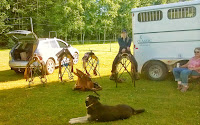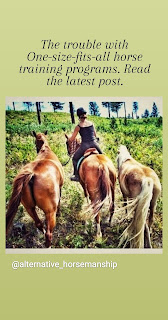
Alternative Horsemanship™ with Samantha Harvey the Remote Horse Coach teaches horse behavior, horse training, and coaches horseback riders of all experience levels. Offering horsemanship clinics worldwide, distance horse coaching instruction, horse video learning catalog, equine consultations, equine re-education and rehabilitation, colt starting, and lessons. Follow her #alternativehorsemanship on all social media platforms.
Pages
- What is Alternative Horsemanship?
- About Equestrienne and Horse Coach Samantha Harvey
- Full Immersion Horsemanship Clinics
- Remote Horse Coach- Personalized Distance Learning
- Client Testimonials
- Video Courses & Classes
- Horse Behavior Course
- Horse Shopping Help Online Course
- Livestream Horse Learning
- Horse Webinars
- YouTube
- TikTok
- Newsletter
- Horse Humor Journal
Help- My horse suddenly stops moving forward!
Horse Problems- Tacking up Assessment
Most people never consider how the horse responds to just the sight of tack or notice if there are Quality Conversations while doing so.
Each part of the interaction influences the mental reasonableness and physical softness that follows.
While the norm (often out of convenience) is to tie the horse while tacking, the degree of bother or concern a horse may have while doing so frequently is suppressed.
I suggest practicing tacking the horse without tying him. The goal is not about getting tacked up.
It is an Opportunity to notice how your horse feels about standing while you are moving around him.

Dangerous, Dramatic, Reactive, Anticipative, Fearful Horses
It isn't Convenient
When the horse is...Resistant to being caught
Constantly pulling when led
Pulls back or gets stressed when tied
Always moving away when trying to tack up
Steps away when trying to mount
Walks off as soon as the rider is in the saddle
Is drifting, bracing, or anticipative when ridden
Takes "awhile" to load into the trailer
Might explode out during the trailer unloading
Is "buddy" or barn "sour"
Has the same "issue" with the same scary spot repeatedly
Offers dramatic behaviors when something unexpected arises
Paws, paces, cribs, weaves, wall kicks, bites while in his enclosure
Is aggressive towards other horses or at feed time
Etc., etc., etc.
Every single unwanted unfortunately common horse behavior above, is a symptom.
Most people try to band-aid the symptom by adding more pressure to the already fearful and defensive equine.
Then one unwanted behavior morphs into another because the root cause was never addressed.
The horse that is left living in a state of constant fear and anticipation because they are defensive toward human interaction leads to mental and physical trauma.
It isn't a matter of "if" they explode, get hurt, or injure the human, but when.
Please stop ignoring the subtle, reasonable behaviors the horse conveys reflecting his fear and defensiveness.
Please start prioritizing slowing down, breaking down the communication to offer short, specific, clear, supportive, and non-critical information that has meaning to the horse.
The horse is not trying to wreck your day, annoy you, psych you out, etc.
The only thing he is trying to do is find a safe space. If every time you show up you bring chaos, distraction, hurried behaviors, anticipation, and unclear communication, what are you teaching him?
To get the Change in the horse, first we must start with the Human.
Dear Sam: Horse Hep *Dangerous Equine Behavior
Alternative Horsemanship with Samantha Harvey the Remote Horse Coach shares how dramatic and dangerous horse behavior is a symptom, how to recognize the initial subtle signs of fear, defensiveness, or anticipation in the equine, and why it matters to address it early, rather than ignoring it and creating the dangerous horse.
Biting, Reactive, Dangerous Horse, or Pain Issues? Equine Ulcers
Surprising, Overhwelming, or "all of a sudden" moments with the Horse
The equine's body is a reflection of his brain and emotions.
Is the horse's movement a problem? No.
It is the result of his asking for support that was "answered" with the use of more pressure "driving" him into complying. Which "worked," until it didn't.
Helping The Hyper Alert and Pushy Horse
I did a lesson recently with Nora and Moose and thought it would be good to share. Much of what comes up in his "coping mechanisms" is very common with horses that are bigger in size.
Dear Sam: Horse Help *Re-evaluating Horse Problems by Alternative Horsem...
Alternative Horsemanship with Samantha Harvey the Remote Horse Coach
Subscribe to the YouTube Channel for weekly horse learning opportunities with new videos posted every Friday.
Assessing the Horse's Diet- Health, Unwanted Behaviors, and other Concerns
Dear Sam: Horse Help Horsemanship Series *Hyper Alert Horses
Horseback Riding: Directing the Horse's Thought vs. Making him Physically Comply
Improving our Horsemanship
Most folks approach riding with a focus and priority on the human's wants and a whole lot of emotion.
This filters their perception of why a horse is behaving a certain way, and then they create a "story" around that usually with the plot lot line being them vs. the horse.
Sometimes out of ego but mostly due to instruction from others.
When the story is eliminated, the person can begin to have an empathetic approach and realize all of the unwanted behaviors are a reflection of the horse needing clear, specific, intentional communication to help him receive the same support as if in the herd.
The horse demands a mental presence from the rider that most people have never even considered.
If a quality relationship is desired it takes adaptability, effort, experimenting, and follow-through.
But those traits are becoming less present in our instant gratification society. So our Horsemanship is a reflection of our personal choices. ❤️🐴🐴
Horsemanship- Tack Fit Challenges
Tack fit... or perhaps I should say Mis-Fit. Probably ranking in the Top 3 challenges faced by riders. It is a major contributor to unwanted experiences in the equine partnership.
One Step at a Time with the Horse
Tying the Horse- It isn't about "making" him stay
Why the one size fits all "Horse Training Program" can be detrimental
"I have to..." vs. "I get to..." with our horses

I recently was listening to a non-horse related lecture and it reminded me of something I "knew" but I wanted to revisit more specifically.
For many people, as they experience unwanted scenarios with their horse, they start fixating on the potential unwanted outcomes. I did a #FifteenForFriday (you can sign up HERE to participate) talk on this a few months back. It is very easy to fall into the pattern of thinking negative thoughts and then acting defensively about the potential experiences that can occur with the horse.










